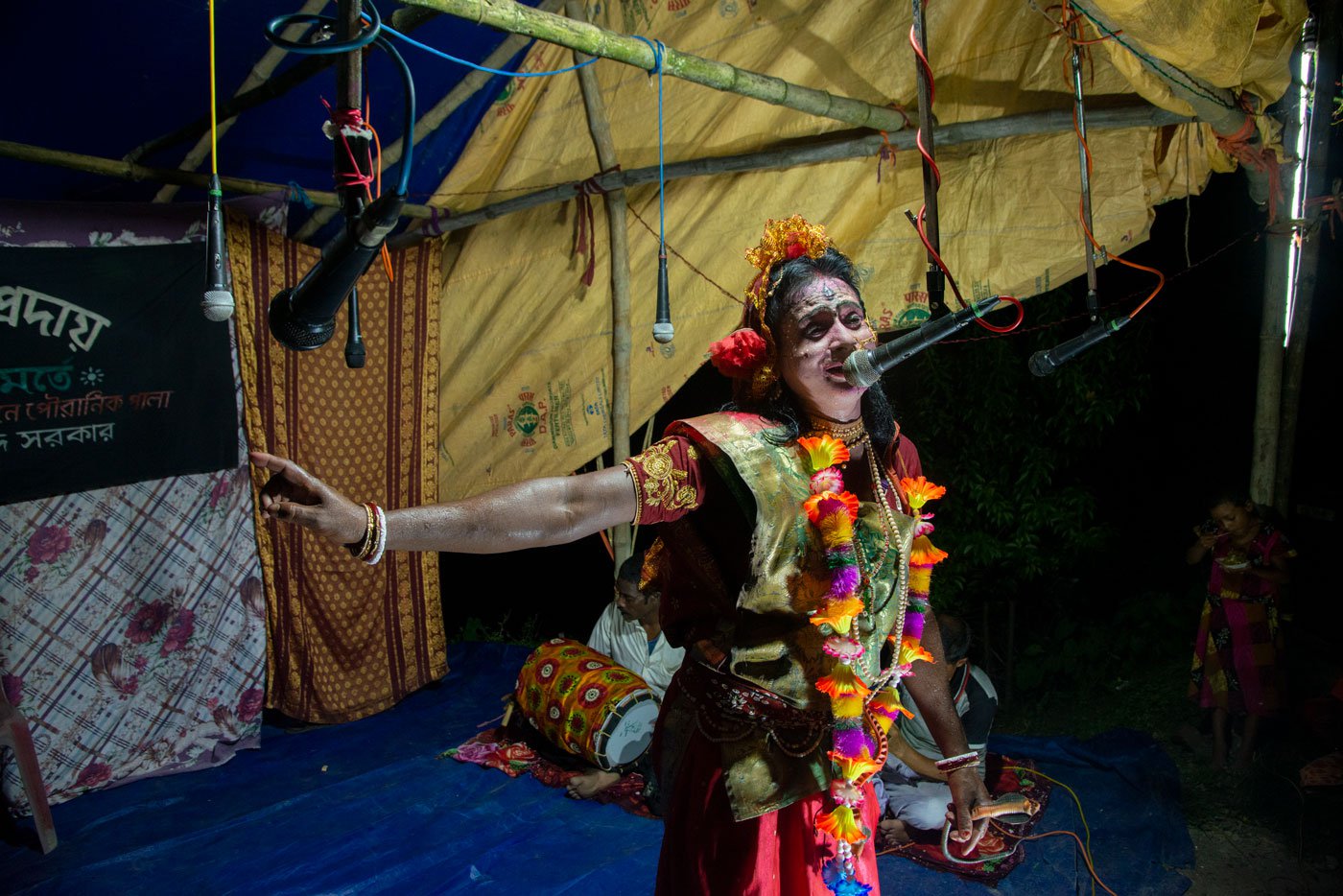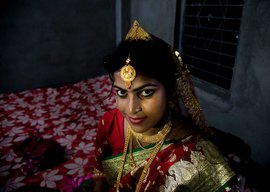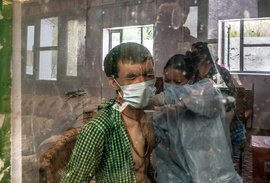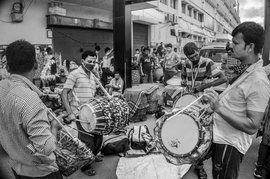The goddess will descend on earth any minute now, provided he gets a chance to dress up first. “It's already seven. Dear residents of Rajat Jubilee village, please bring bedcovers, sarees, cloth. We need to create a green room. The ‘ pala gaan ’ – Manasa elo morte [Goddess’ arrival on the earth] is about to begin.” Announcements prior to the musical performance resound through the air, animating the still September evening in the lanes of this village in Gosaba block of South 24 Parganas district. The night promises festivity and jubilation.
Within an hour, a makeshift green room has come up and is bustling with artists in bright attire applying make-up, adorning themselves with jewellery and rehearsing their lines from an unwritten script. Nityananda Sarkar, who leads the team, wears a sombre look, unlike the cheerful dancer I first met during
Hiranmay and Priyanka’s wedding
. Today he will play Manasa, the snake goddess. He introduces me to other artists who will participate in this evening’s
pala gaan
.
Pala gaan
is a musical drama based on Mangal Kavya, an epic narrative eulogising a popular goddess or deity. These narrative poems are often recited or sung in praise of various pan-Indian gods like Shiva, but more often of local Bengali deities like Dharma Thakur, Ma Manasa – the snake goddess, Shitala – the goddess of smallpox, and Bon Bibi – the goddess of the forest. Troupes of artists move around the islands of the Sundarbans throughout the year to perform these musical dramas before captivated audiences.
Manasa
pala gaan,
which is performed across parts of West Bengal, Assam and Bihar, is based on the Manasa Mangala Kavya, an important epic poem which, in one estimate, dates back as far as the 13th century, and which in is turn said to have been based on older folk myths. In Bengal, Manasa is a popular goddess among the Dalits of South 24 Parganas as well as Bankura, Birbhum and Purulia districts. Every year, on the day of Vishwakarma Puja (September 17 this year), many households in remote villages in the Indian expanse of the Sundarbans worship the snake goddess and perform the
pala gaan
.
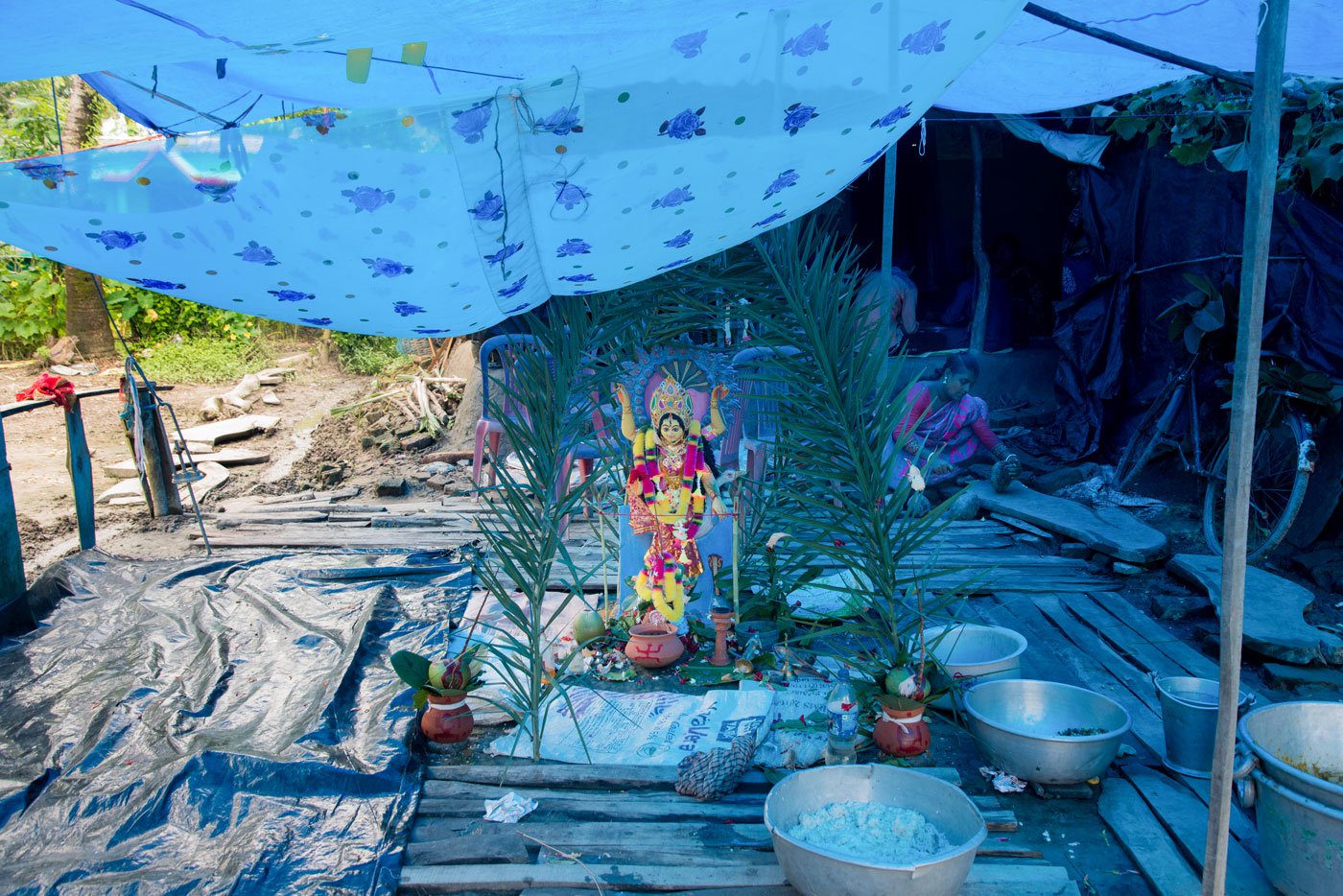
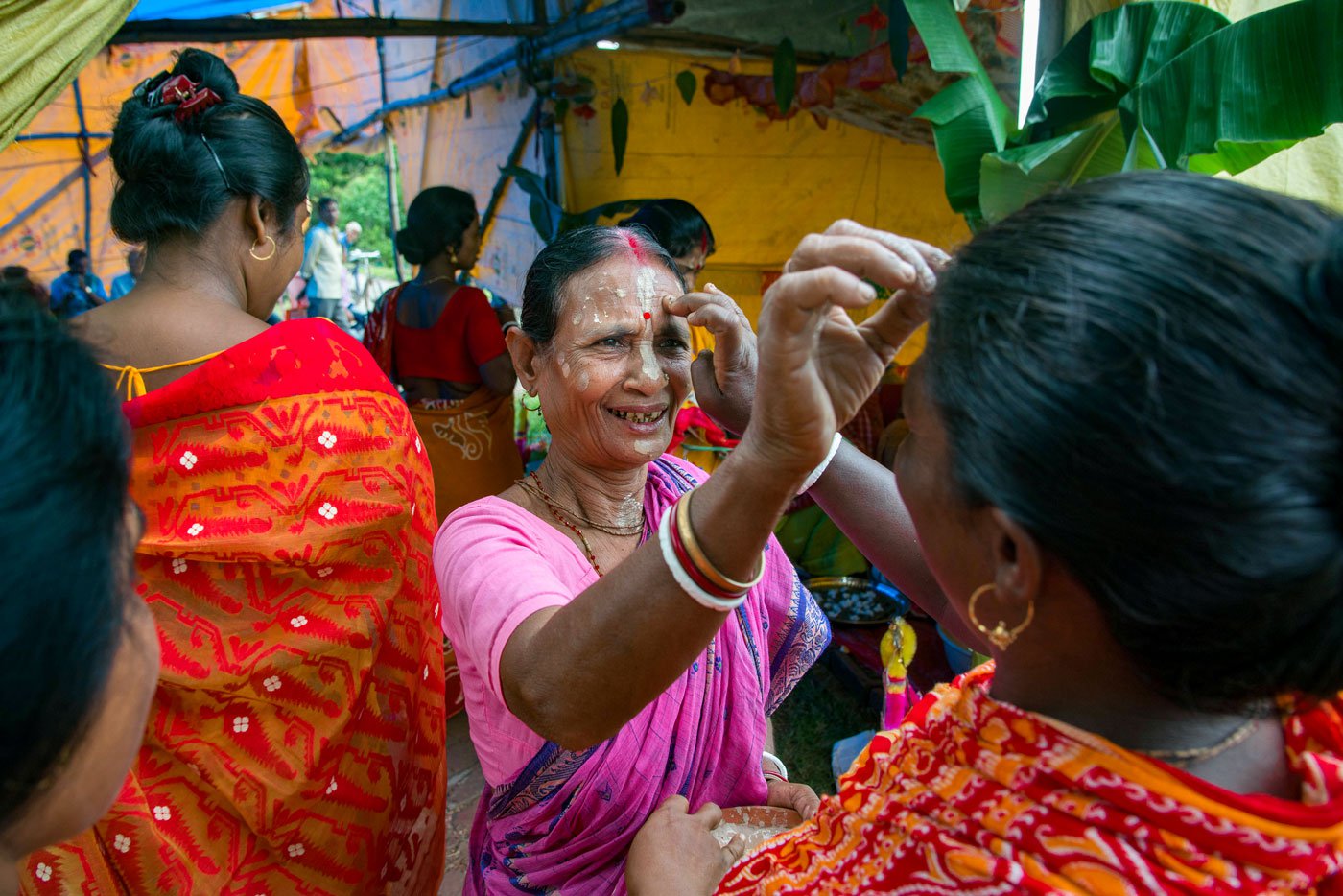
Left: Snake goddess Manasa is a popular among the Dalits of South 24 Paraganas as well as Bankura, Birbhum, and Purulia districts. On the day of Viswakarma Puja (September 17 this year) many households in remote villages in the Indian expanse of the Sundarbans worship the snake goddess and perform pala gaan . Right: Older women in Rajat Jubilee village welcome others in the community to the Puja
The musical-ritual that strings together stories of Manasa’s prowess is an invocation, a prayer to protect the people of the Sundarbans from the venomous serpents of the island. There are more than 30 species of snakes here, including some of the most poisonous ones like the king cobra – and snake bites are a common cause of death that often go unreported in this region.
Today’s performance revolves around the story of a wealthy Shiva devotee, Chand Sadagar, and his obstinate refusal to accept Manasa as a supreme goddess despite her repeated attempts to win him over. In a string of incidents of retaliation, Manasa destroys Chand Sadagar’s cargo at sea and kills seven of his sons by snake bite, also killing one more son, Lakhinder, on his wedding night. Mad with grief, Lakhinder’s wife Behula travels to heaven along with her husband's body to reclaim his life. There she is advised by Indra to convince Chand Sadagar to worship Goddess Manasa. Chand Sadagar puts forward his own counter-conditions whereby he would offer token flowers to Manasa only with his left hand, keeping his auspicious right hand free to worship Shiva. Goddess Manasa accepts this puja and restores Lakhinder to life along with all the wealth of Chand Sadagar.
Nityananda, who plays Manasa, is a 53-year-old farmer and a veteran
pala gaan
artist practising this art form for over 25 years. He works with more than one team for different
pala gaans
. “The situation has been worsening since 2019,” he says. “This year too, because of the pandemic, we have received fewer bookings, perhaps the lowest we have faced. We used to get 4 or 5 bookings a month, but this year we have had only two. Fewer shows mean less income. “Earlier, we artists each used to earn 800-900 rupees from every show; now that too has come down to 400-500.”
Banamali Byapari, a troupe member sitting next to Nityananda, pitches in to explain how demanding a rural theatre can be, with no green rooms, no proper stage, no effective sound and light system, and no proper amenities like toilets. “The shows go on for 4-5 hours. It's very tedious work. We perform it from our passion, not for financial gain,” he says. He has two roles to perform in the play: that of Kalnagini snake, who kills Lakhinder, and a comic character called Bhar, who provides much-needed relief from the high intensity of this drama.
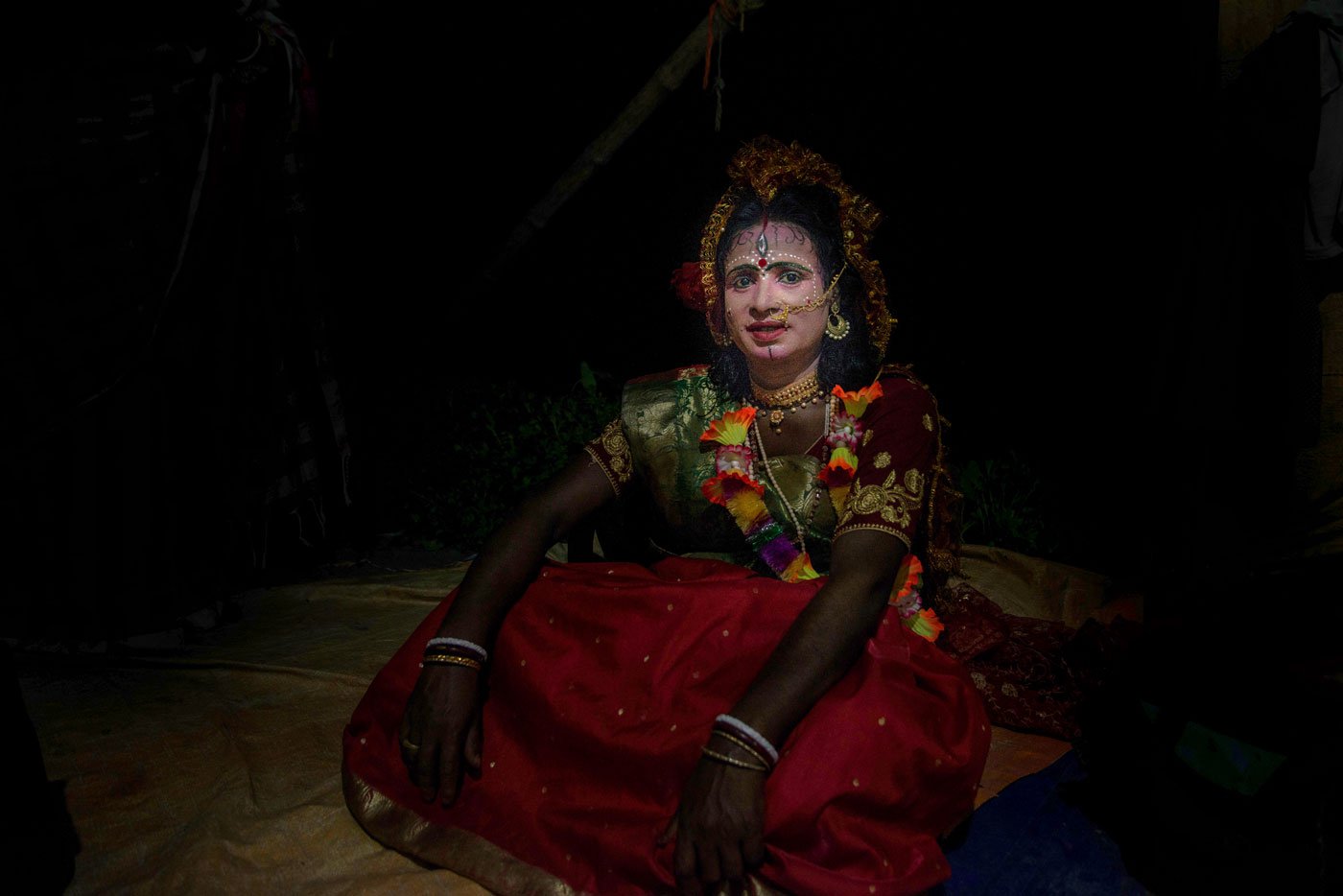
Nityananda Sarkar, the 53-year-old farmer and veteran pala gaan artist plays goddess Manasa. He has been practising this art form for over 25 years. But since the COVID-19 pandemic began in 2019, bookings for his shows have been at their lowest ever. “Earlier, we artists each used to earn 800-900 rupees from every show; now that too has come down to 400-500,” he says
The musicians begin to play their notes, indicating the start of the performance. Nityananda and his all-male team, decked up in their finery, head straight for the stage. The show begins with a prayer seeking the blessings of Goddess Manasa and village seniors. The crowd remains spellbound all through, watching the people they know enact familiar and yet awe-inspiring roles from a divine drama. None of the actors are professionals here – they are all farmers, agricultural labourers or seasonal migrant workers.
Nityananda has a family of six to take care of. “This year, my income from agriculture has gone down to zero because of cyclone Yaas,” he says. “My land went under saline water and now it is raining excessively. My teammates, who are farmers, or work in other jobs, are also facing challenges. Thankfully, I receive 1,000 rupees every month from the government [under the Lokprasar Prakalpa, a state scheme under which folk artists, young and old, receive either a retainer fee or a monthly pension].”
Boys of the younger generation, such as Nityananda’s own son, are not interested in performing pala gaan . Many from the villages of Lahiripur panchayat go to other states looking for jobs as construction workers or agricultural labourers. “The culture is changing. After 3-5 years, this art form may become extinct,” says Nityananda.
“Even the audience preferences have changed. Mobile entertainment is replacing traditional performances,” adds Biswajit Mandal, another performer from the team, who is in his mid-40s.
Now, having spent many hours watching the performance and talking to the artists, it’s time for me to say goodbye. As I prepare to leave, Nityananda calls out: “Please come back in winter. We will be performing Ma Bon Bibi
pala gaan
. You may want to document that too. I am afraid that in the future people will only read about this art in history books."
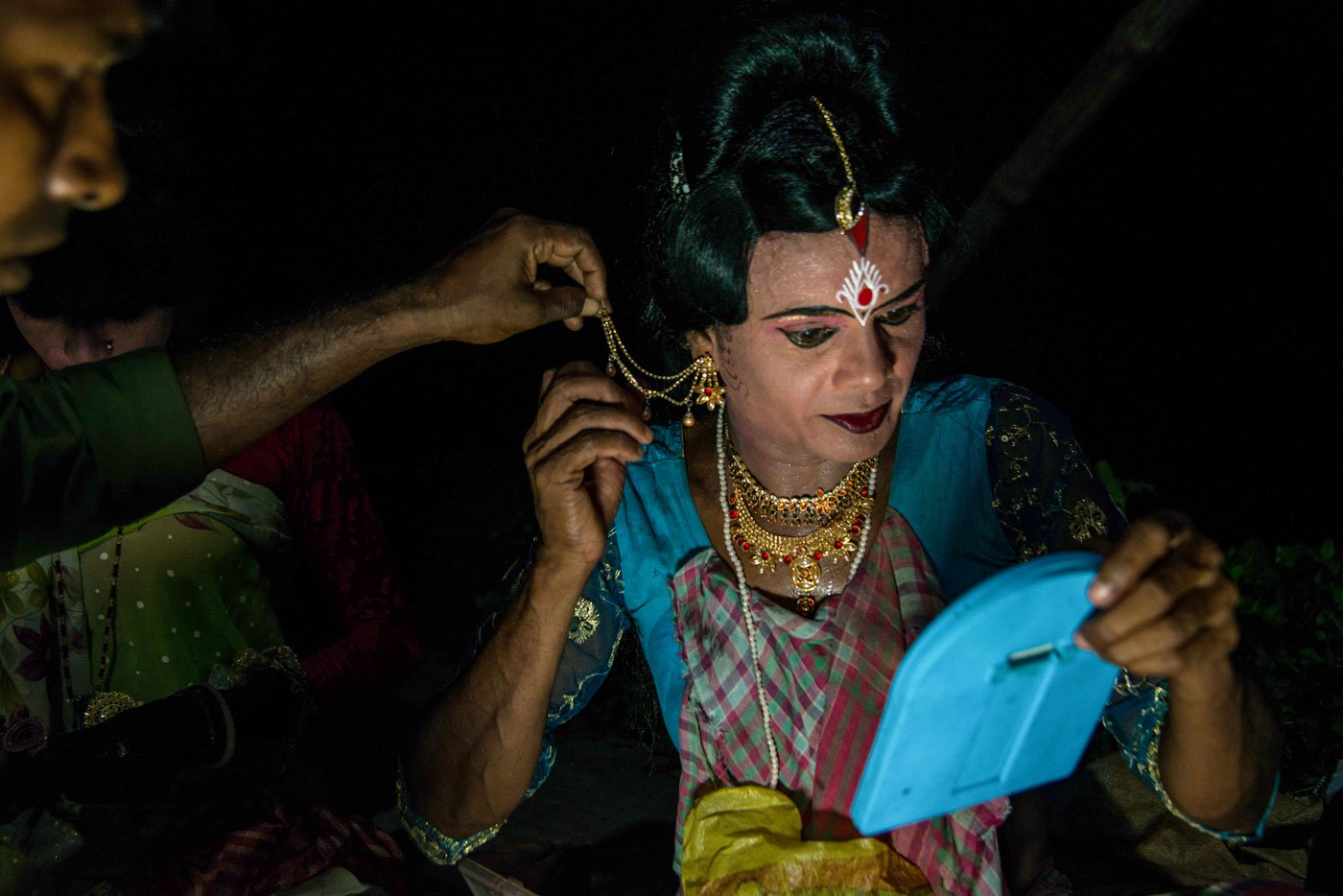
Biswajit Mandal, an artist in this all-male team of Manasa pala gaan performers, checks his finery and make up in the makeshift green room before the show begins
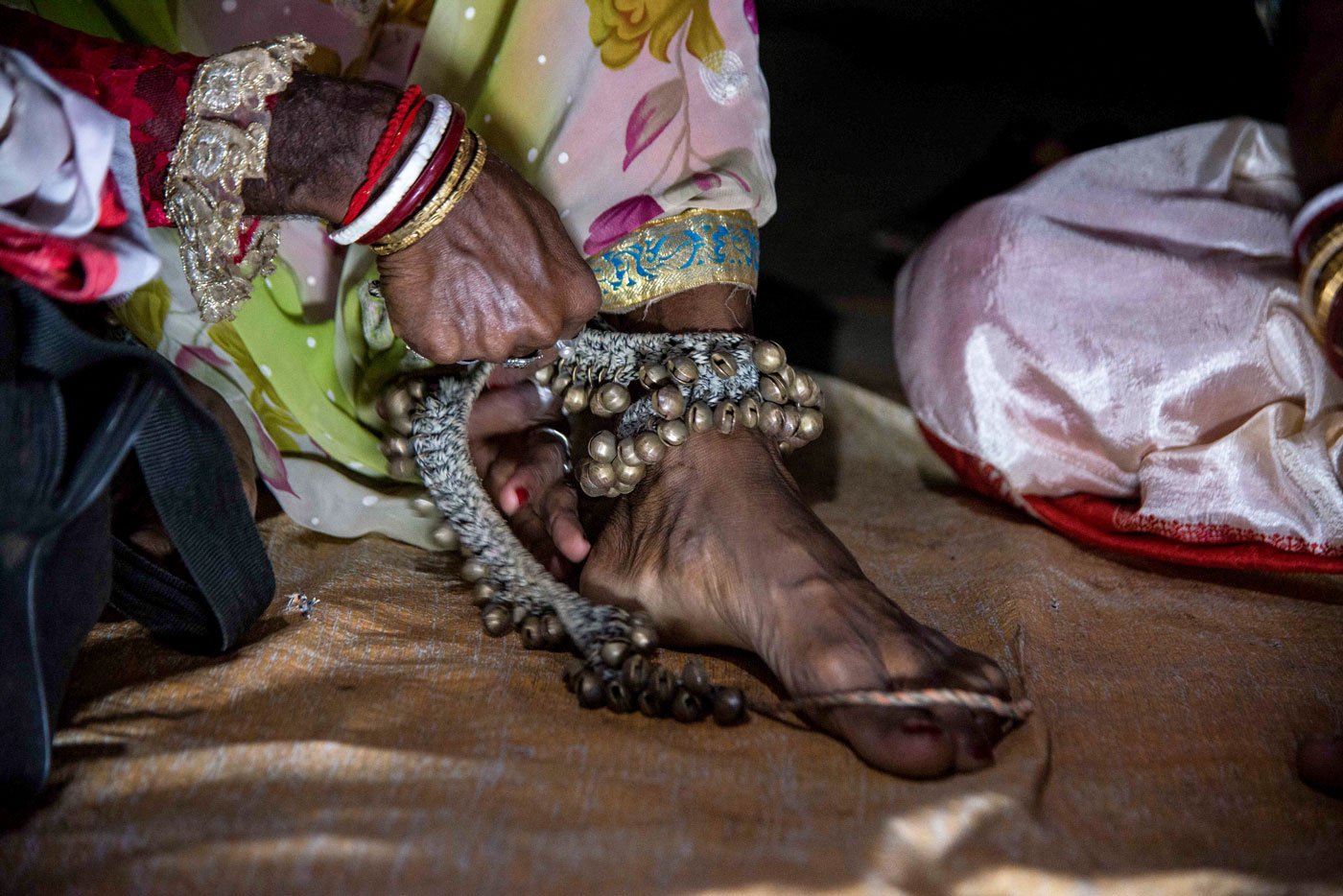
An artist ties on dancing anklets (ghunghru) shortly before he goes on stage
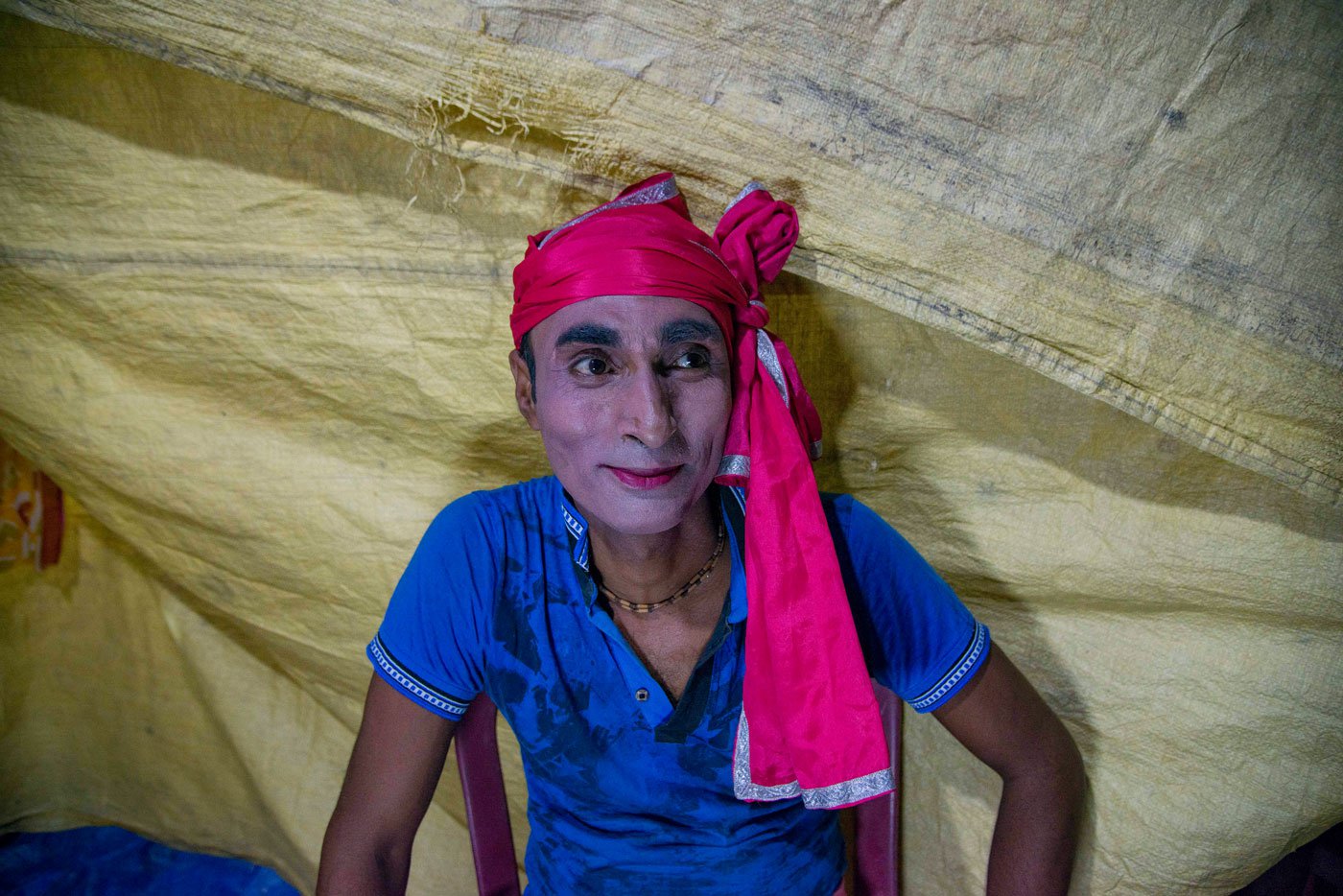
Banamali Byapari has two roles to perform in the play: that of the Kalnagini snake and a comic character called Bhar. The show will continue for 4-5 hours. Rural theatre is demanding, but "we perform it from our passion, not for financial gain,” he says

Swapan Mandal rehearses his part. In the absence of any written script pala gaan artists have to rely entirely on memory
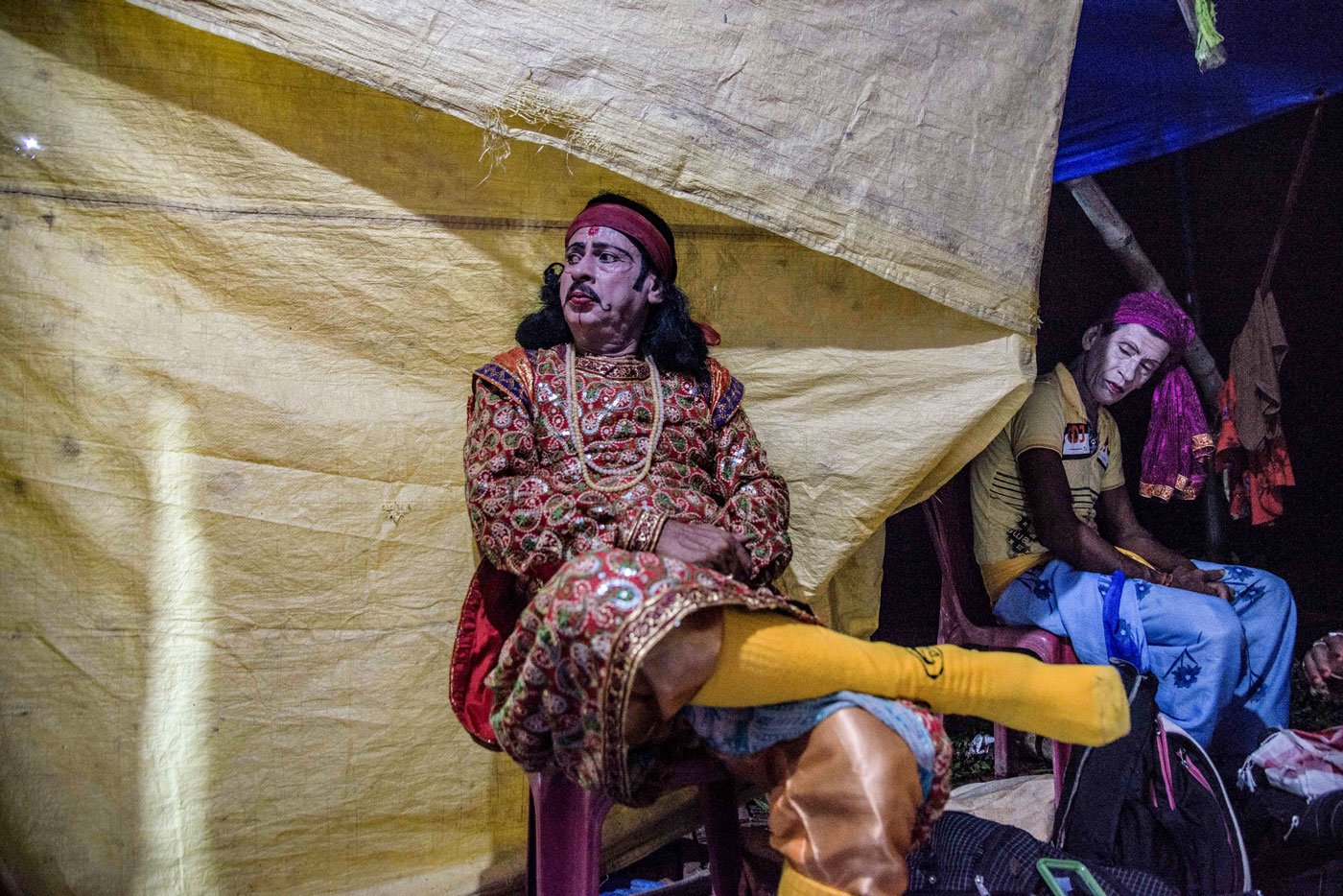
Shreepada Mridha plays the central character of Chand Sadagar, a wealthy businessman and ardent devotee of lord Shiva that goddess Manasa tries to win over
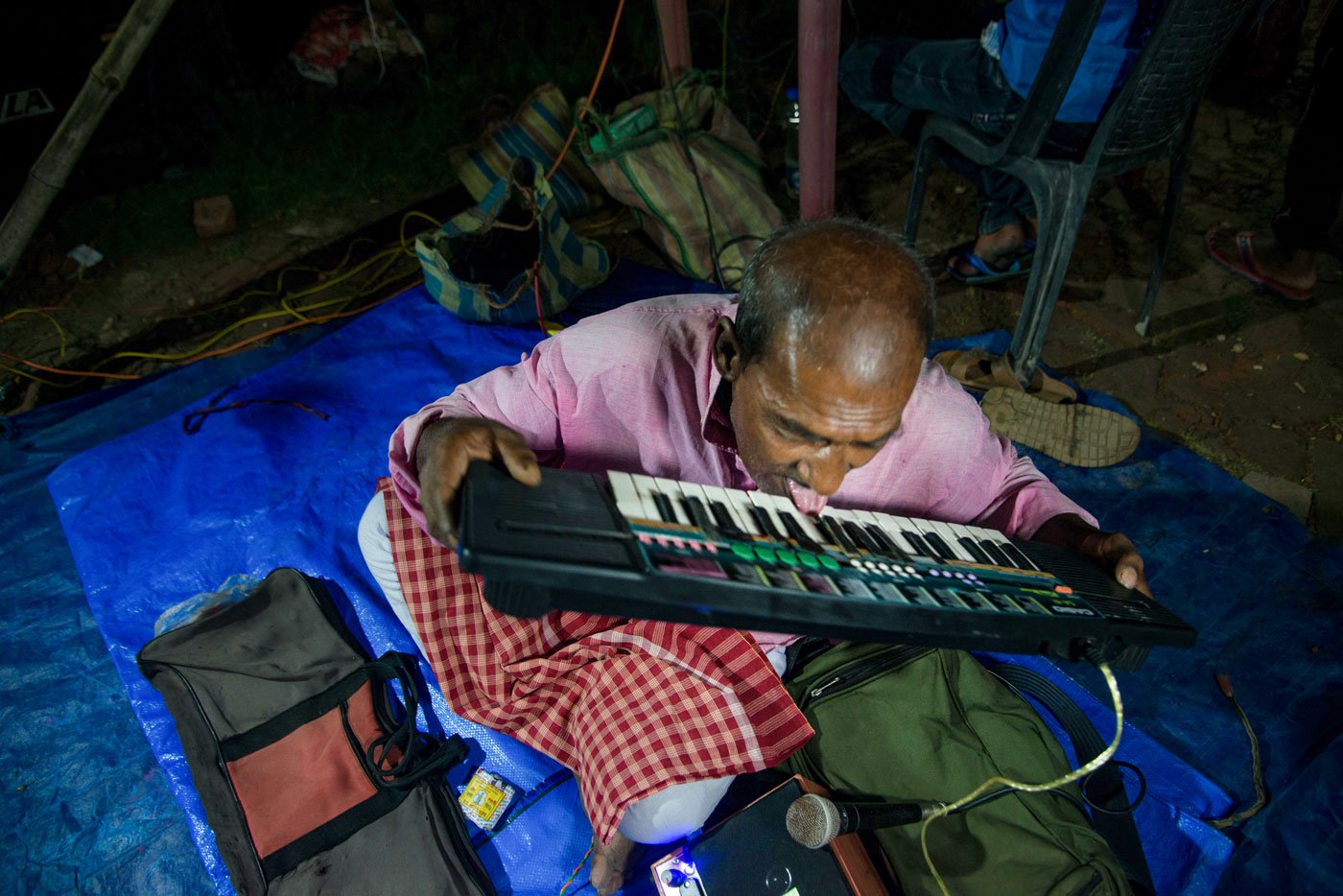
A musician plays the synthesiser with his tongue before the show
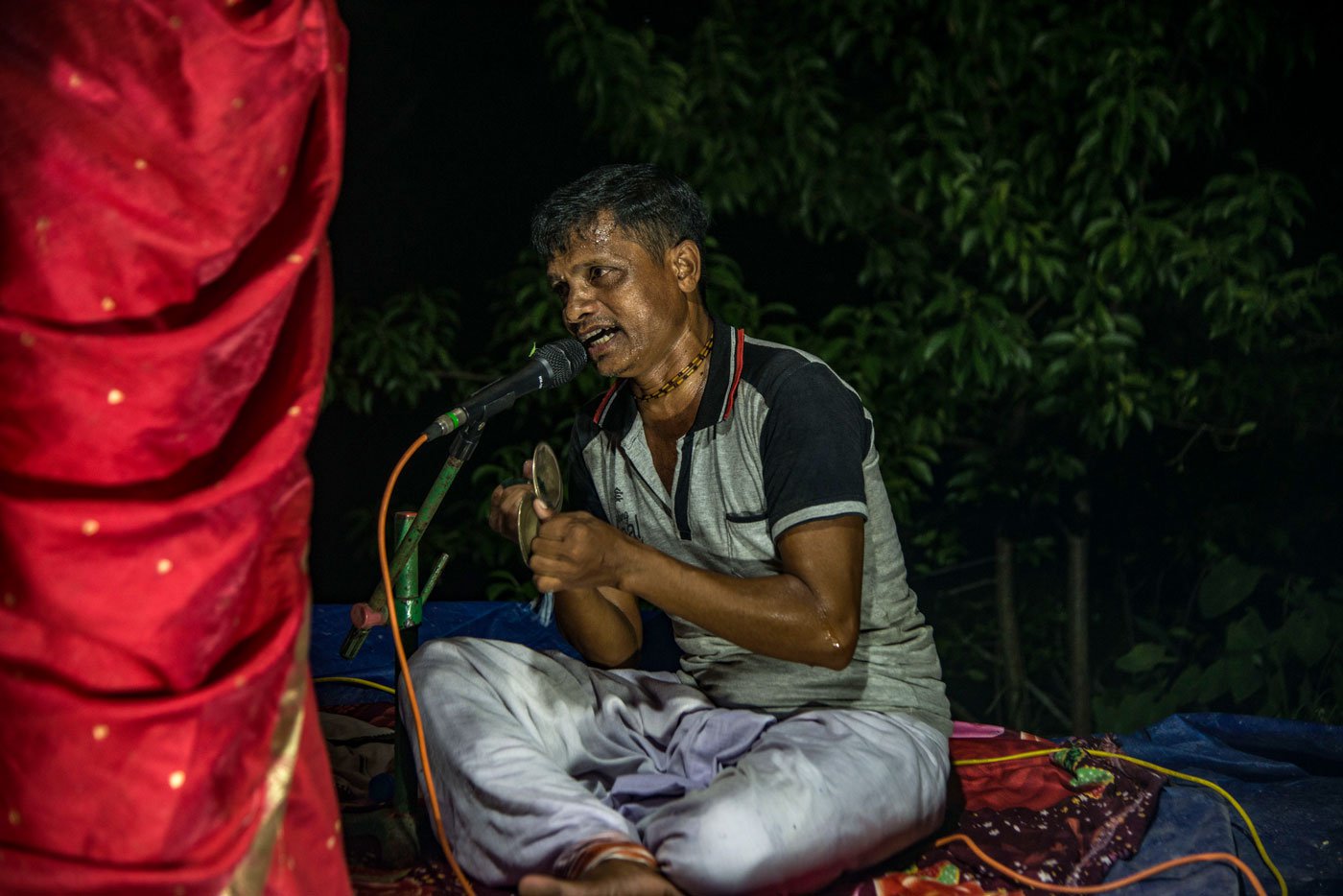
A musician playing Kartal - a wooden clapper - provides background music
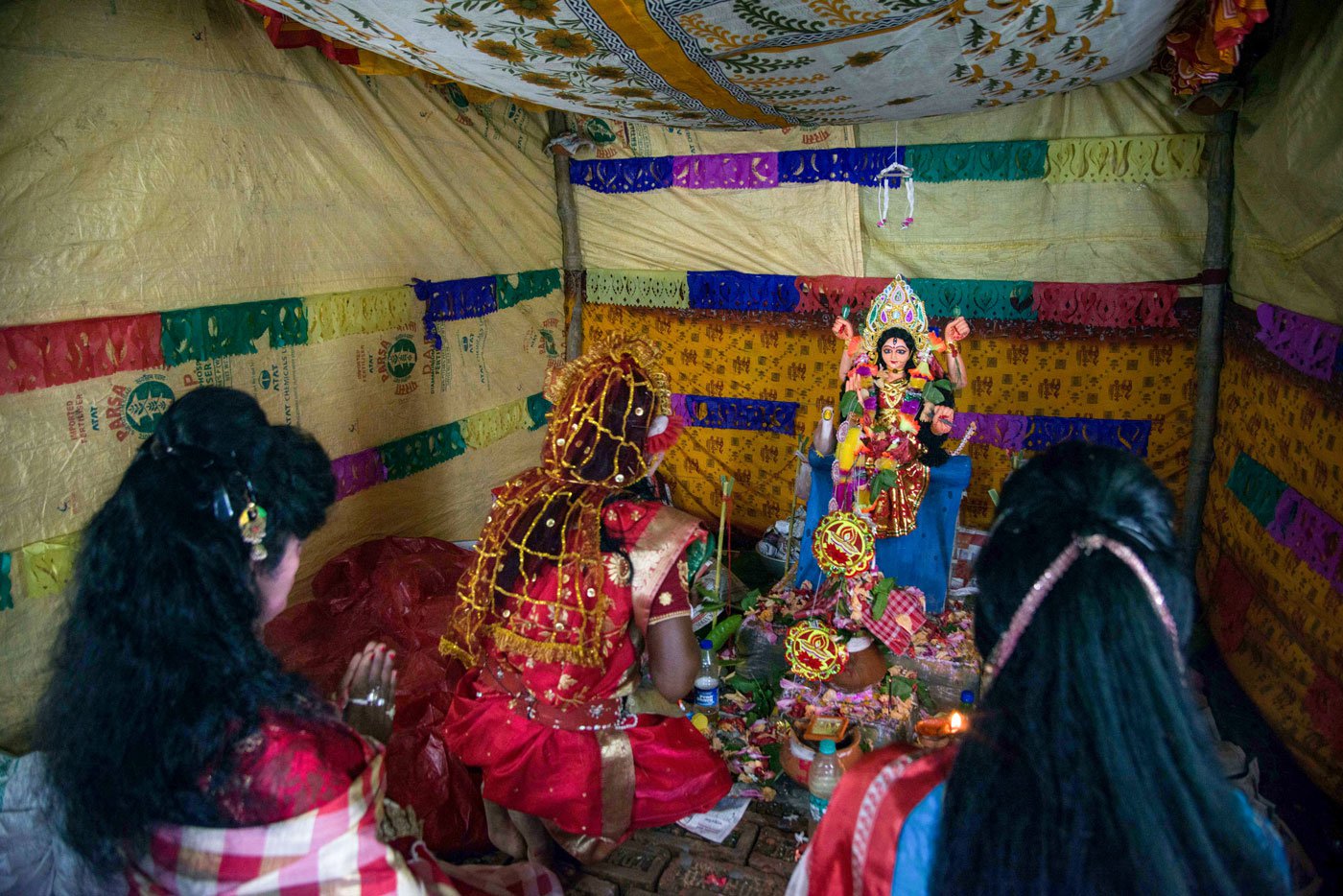
Nityananda and other artists pay homage to the deity at a local pandal before beginning their performance
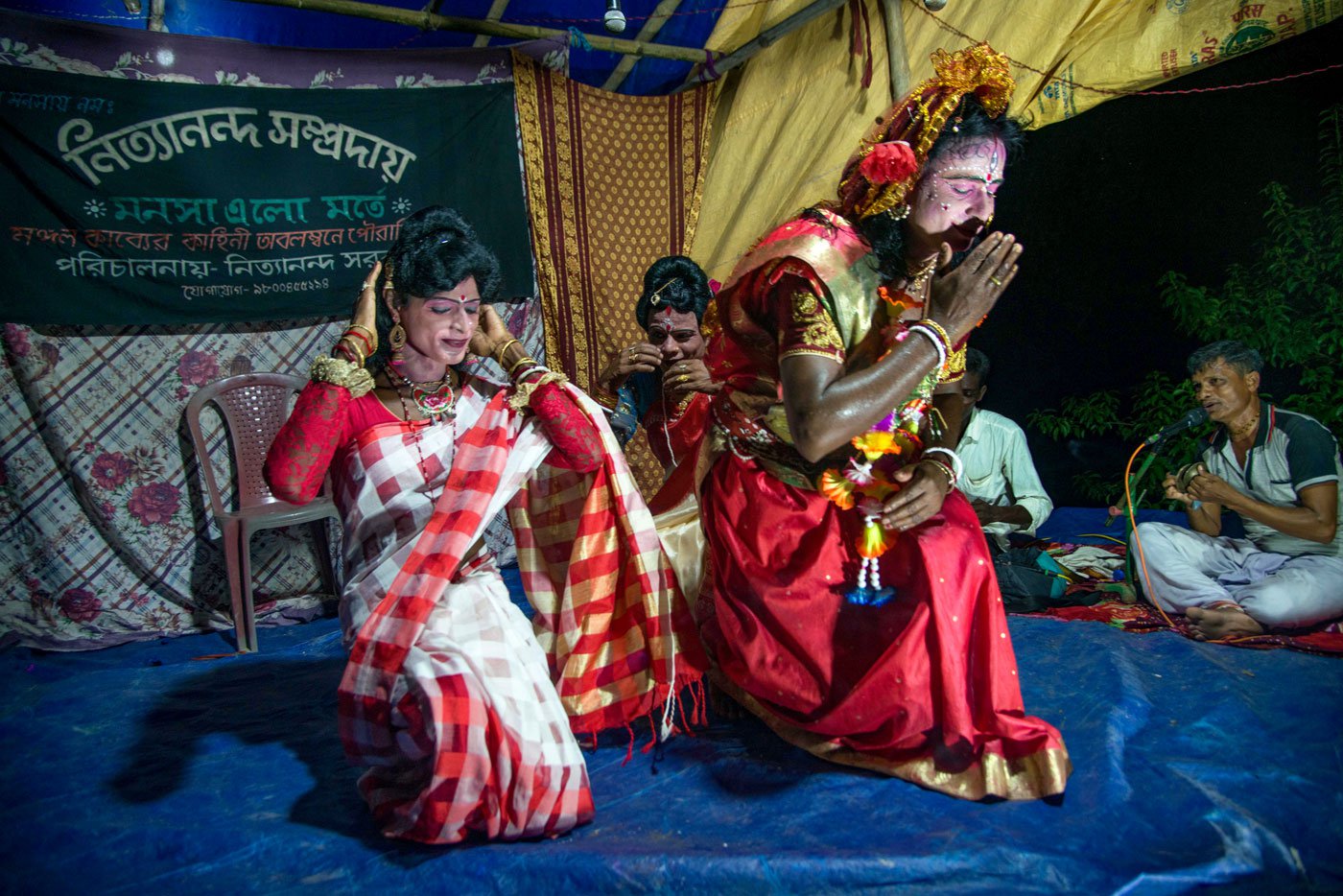
"As artists, we all respect the stage. It's our temple. We must seek its blessing," says Nityananda
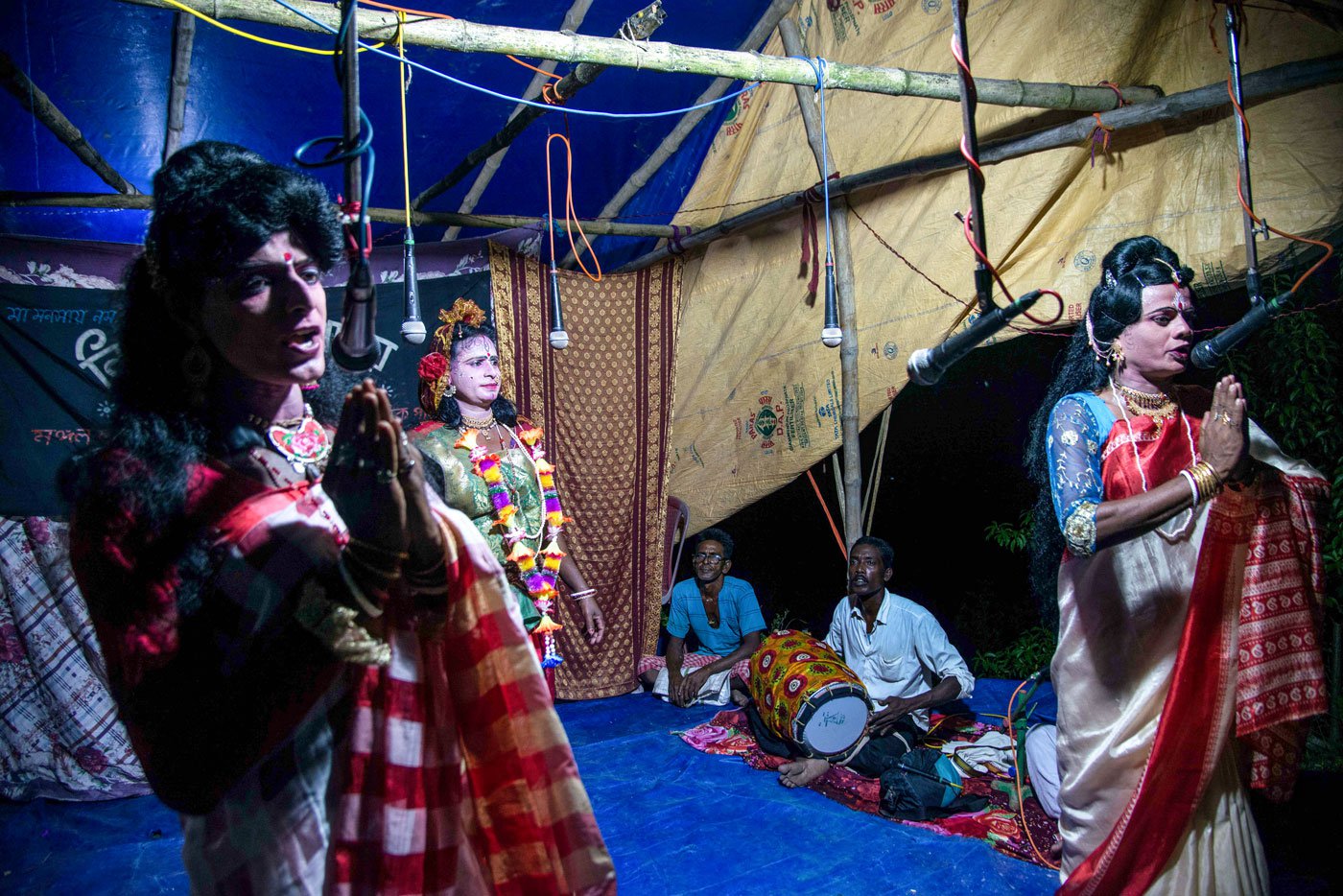
From left: Swapan Mandal (playing Chand Sadagar’s wife, Sanaka), Nityananda Sarkar (playing goddess Manasa), and Biswajit Mandal (playing the daughter of Chand Sadagar) start the performance by seeking the blessings of the village deities and elders in the audience
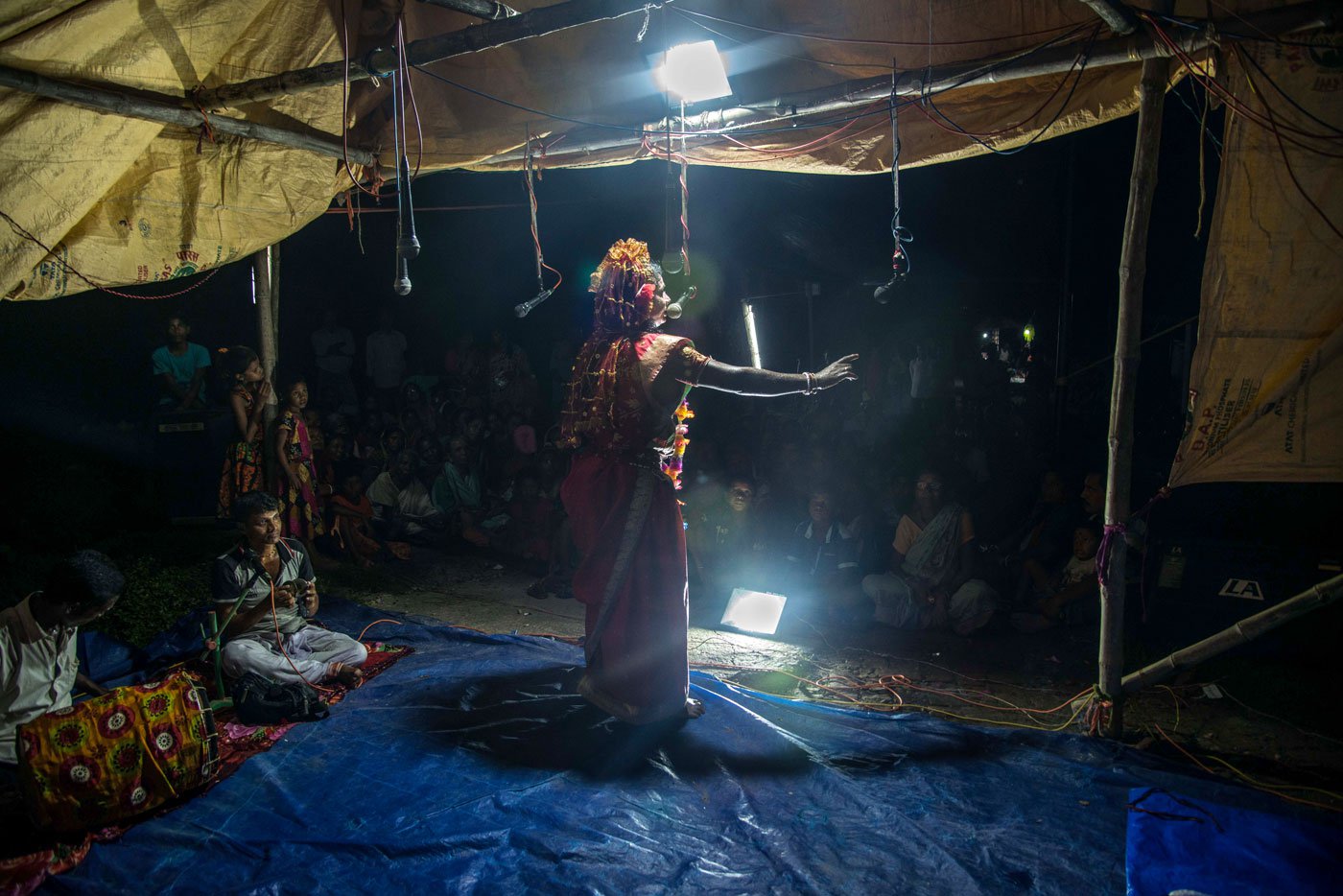
Nityananda playing the part of goddess Manasa holds his audience spellbound
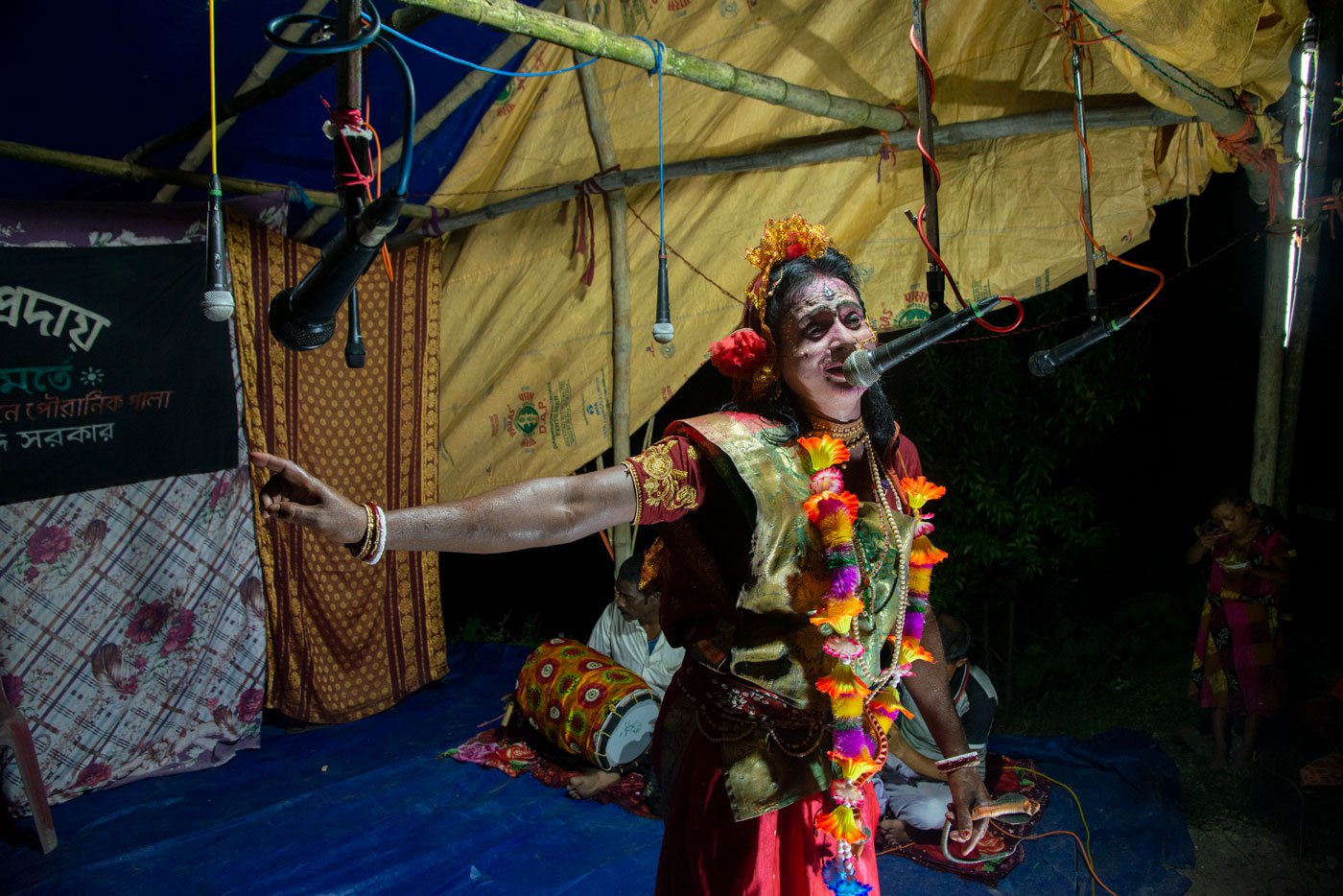
This musical performance is based on the Manasa Mangala Kavya, an important epic poem which, in one estimate, dates back as far as the 13th century, and which in turn is said to have been based on older folk myths

The audience, like this old lady from Rajat Jubilee village, watch in amazement as people they know enact familiar and yet awe-inspiring roles from a divine drama
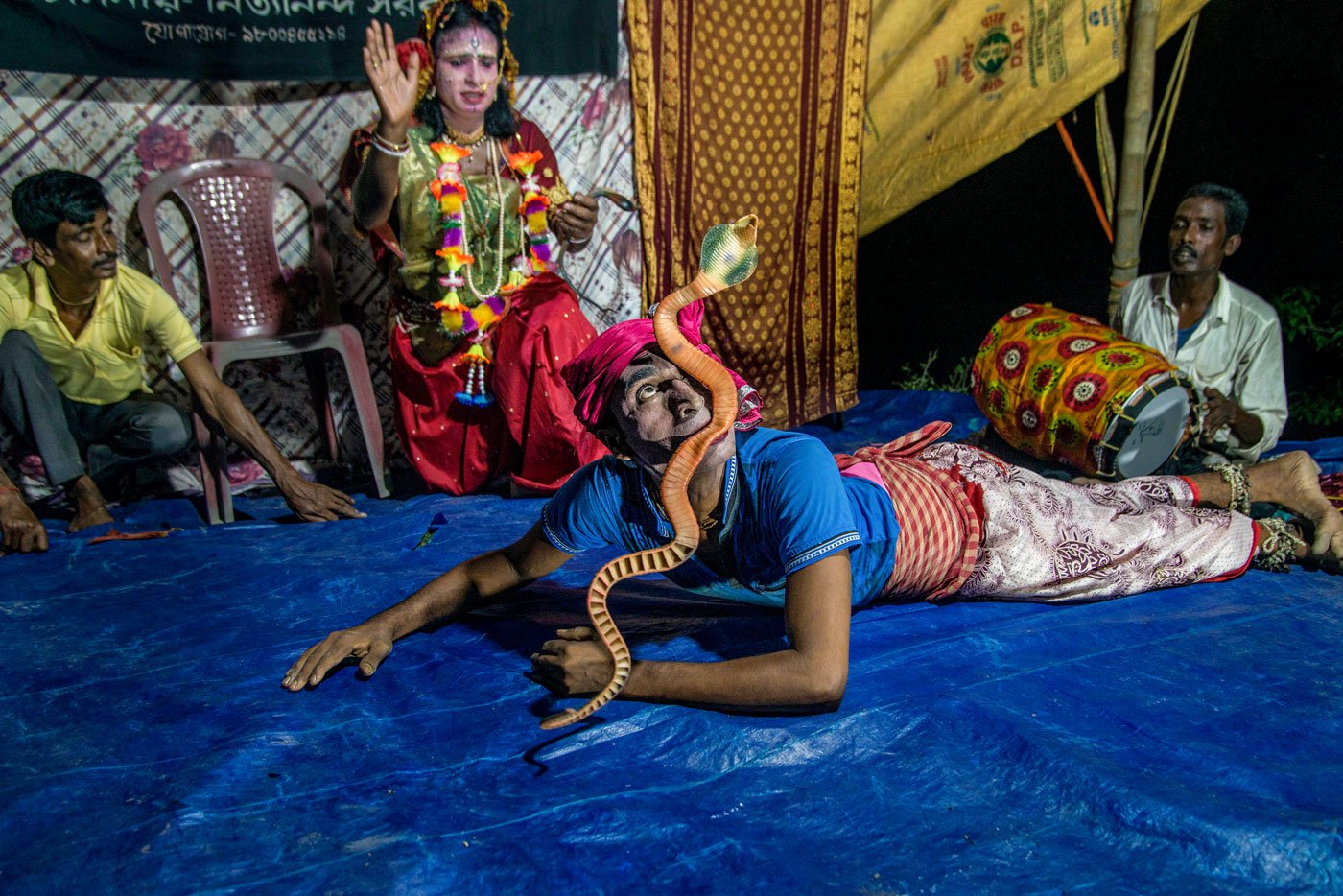
Banamali Byapari enters the stage as the poisonous Kalnagini snake to kill Chand Sadagar's son Lakhinder at Manasa's behest
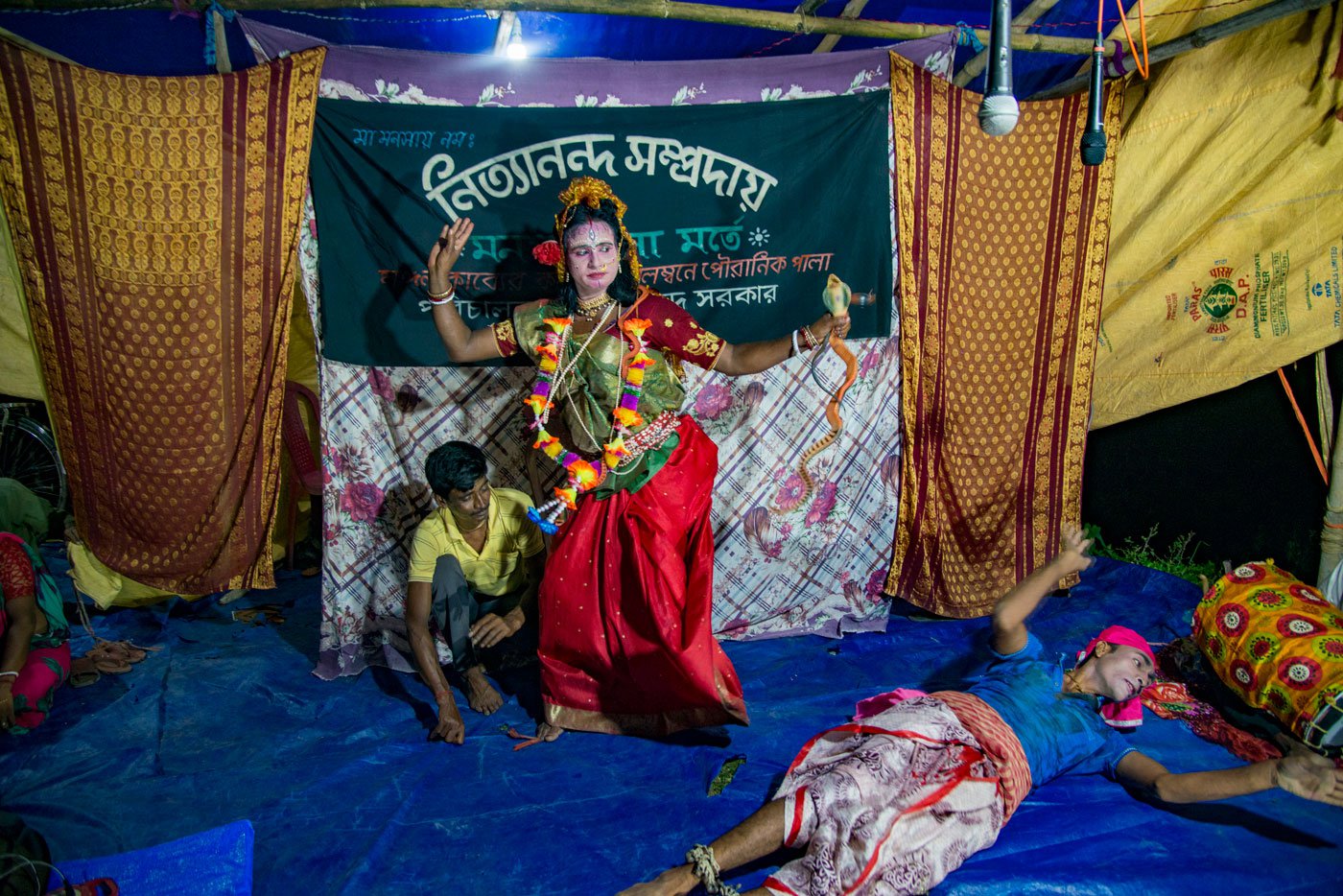
Nityananda as Manasa and Banamali Byapari as Kalnagini snake in the midst of an intense scene
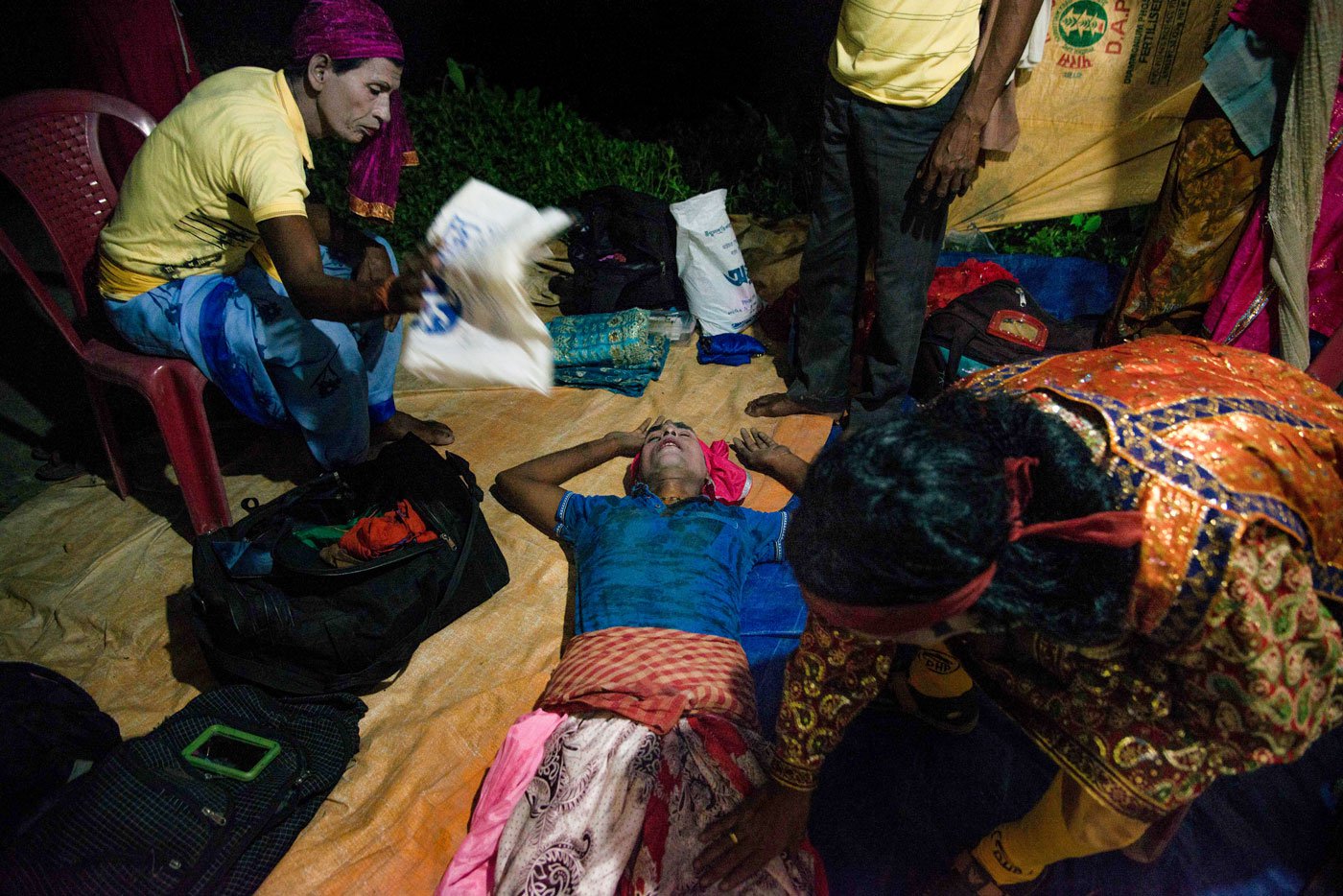
Having performed a challenging scene, an exhausted Banamali goes backstage to take a break, where he faints due to dehydration. None of the actors here are full-time professionals – they are all farmers, agricultural labourers or seasonal migrant workers
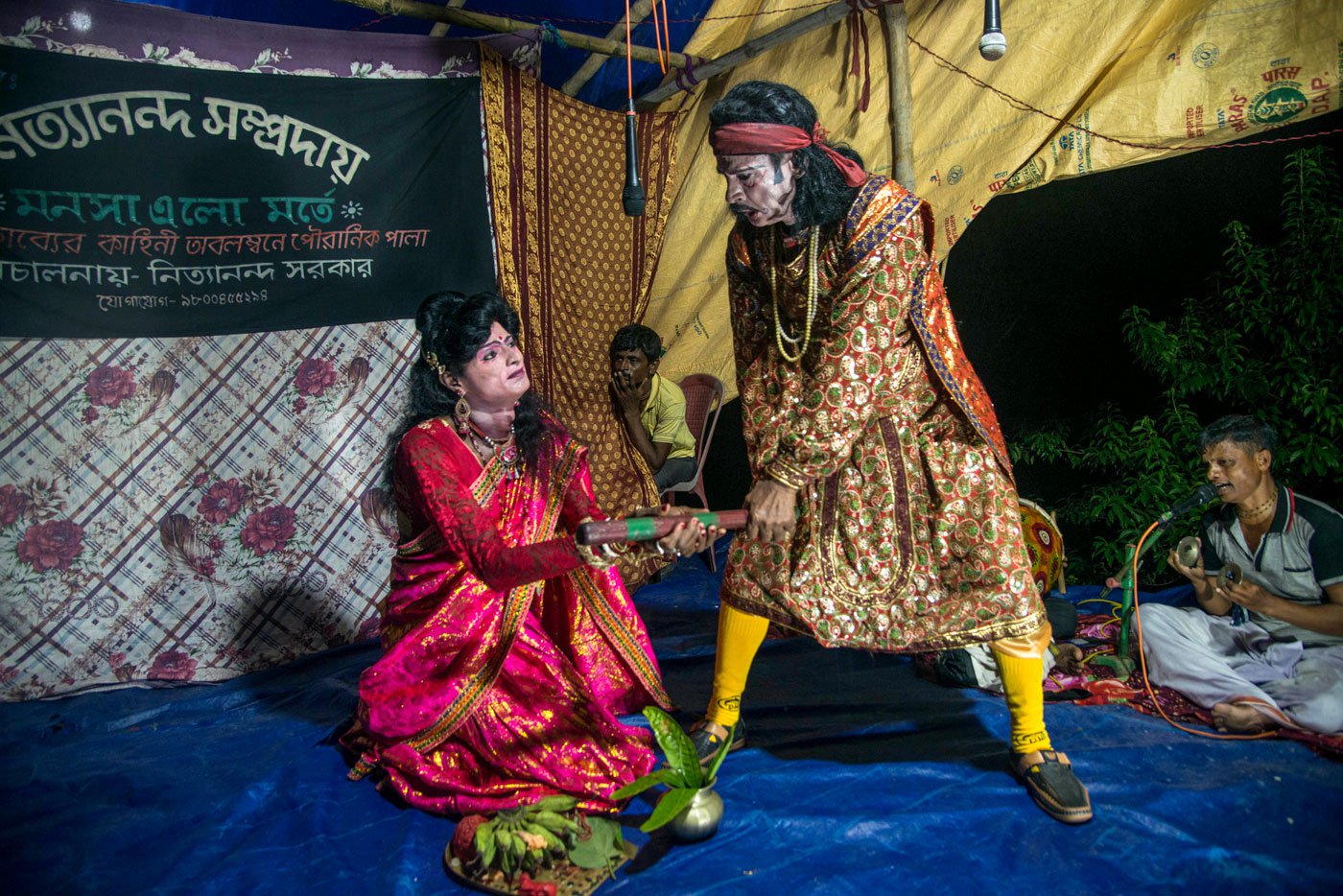
Swapan Mandal (left) as Sanaka, wife of Chand Sadagar, played by Shreepada Mridha
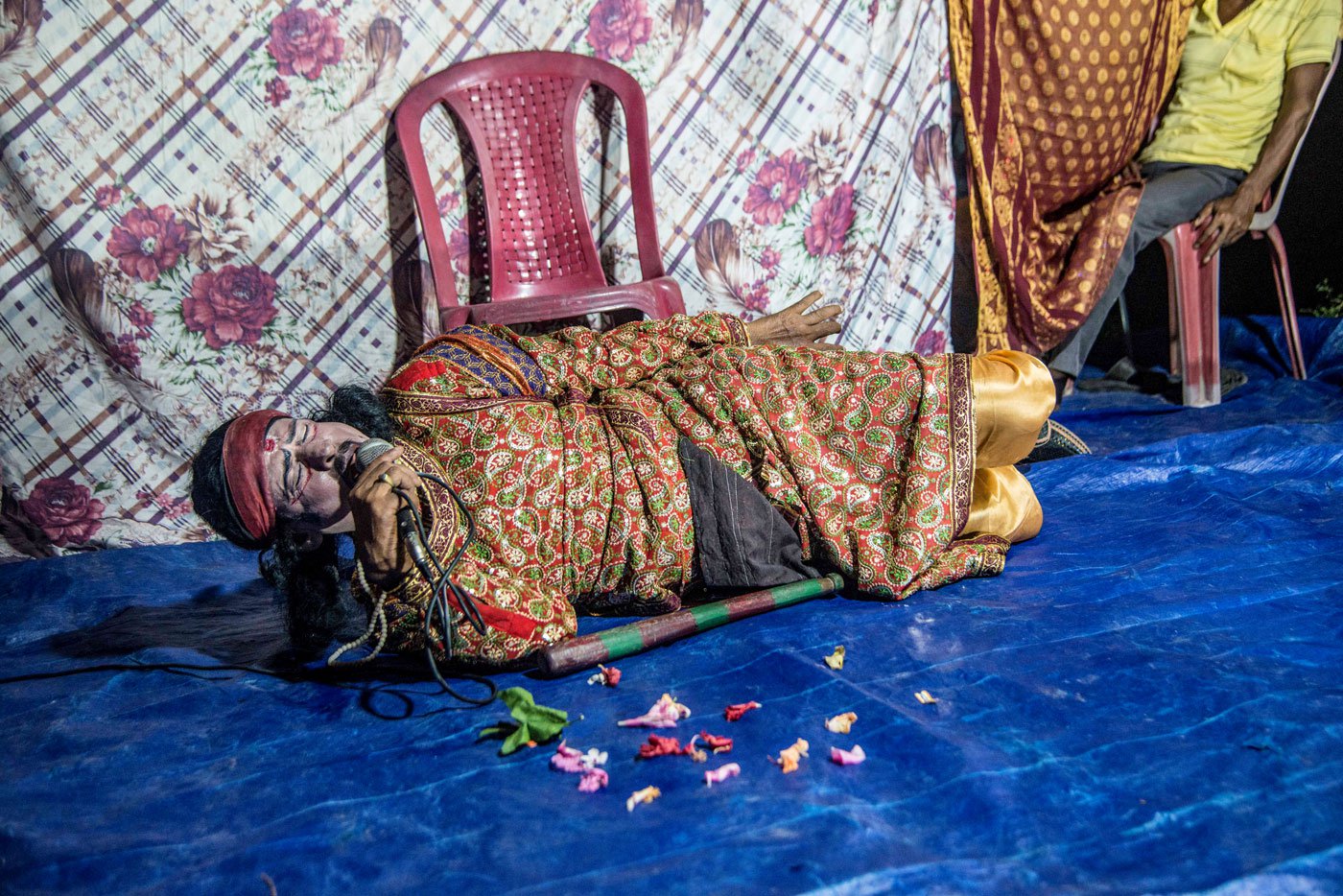
Shreepada Mridha as Chand Sadagar tries to stay afloat in the ocean after his vessel is hit and his cargo destroyed in a raging storm - all because of Manasa's wrath in the face of his obstinate refusal to accept her as a supreme goddess
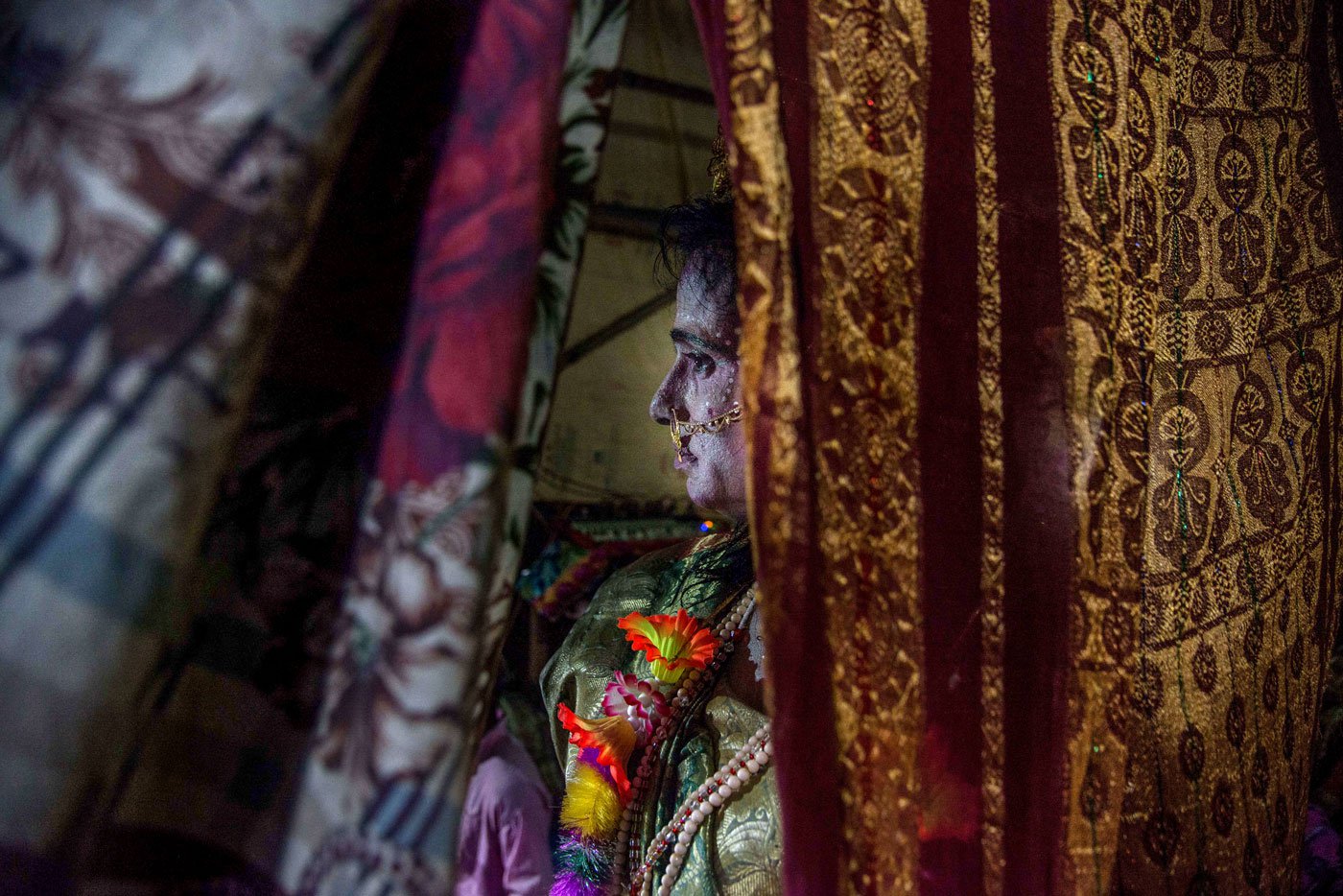
Nityananda carefully observes the performance of each of his team members
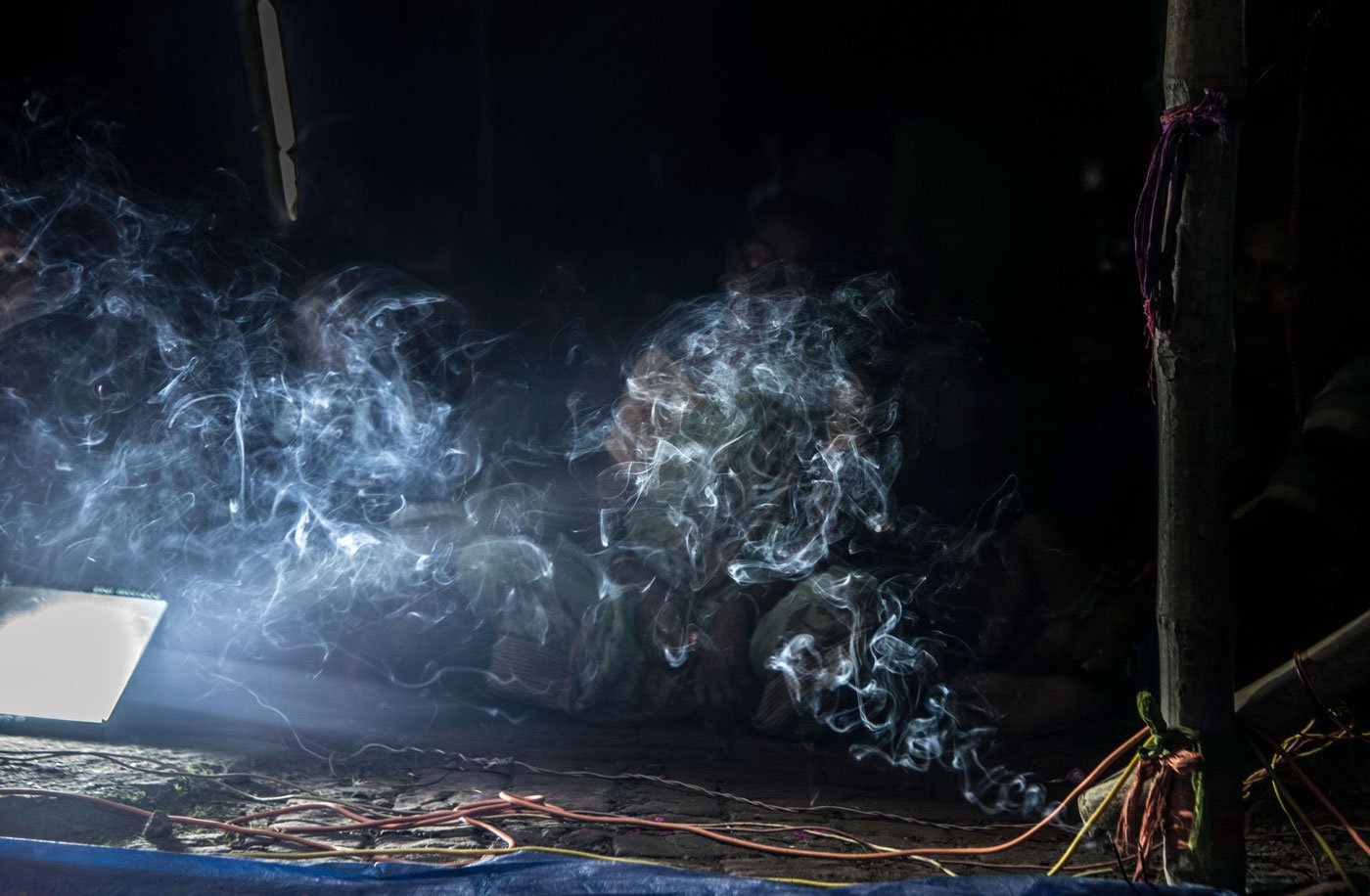
Plumes of smoke wafting from an incense stick towards the end of the show at midnight. The children in the audience are already asleep
